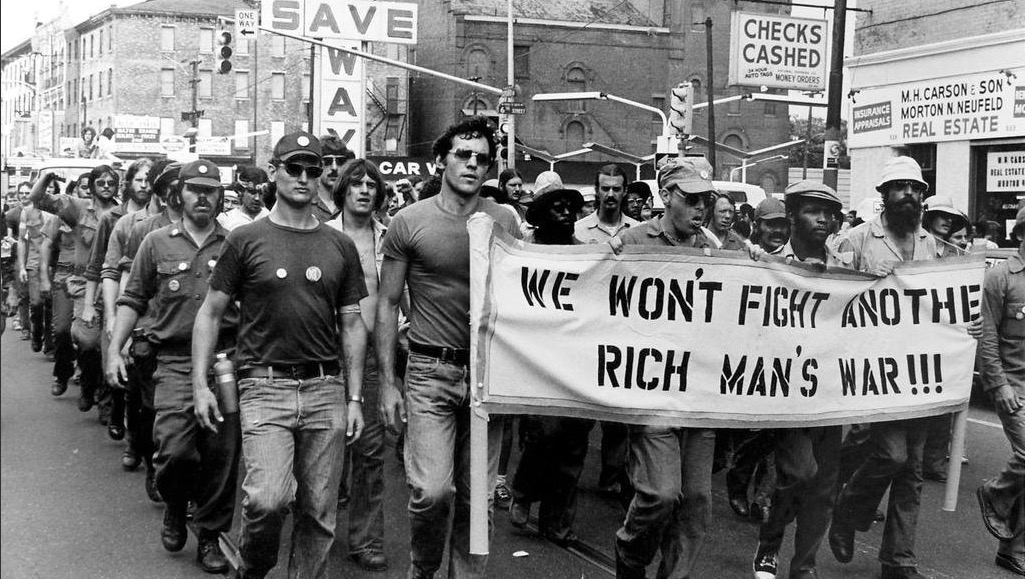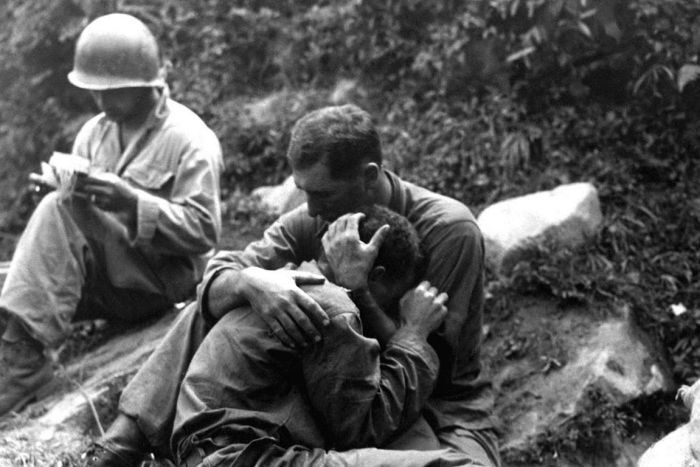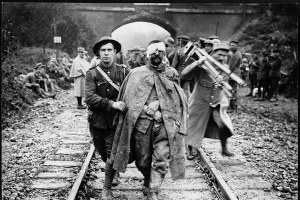Today our nation commemorated Anzac day, with all the usual furver and rhetoric, the politicians clamoring for a photo opportunity; 101 years on however are we even really cogniscent of the significance of the huge sacrifice’s that were made by the men and woman of that generation?
Do our politicians truly comprehend the contract that their predecessors made with the Australian people following armistice in 1918 when social upheavals resulted in a completely reordered society?
Or is it just a case of more of the same, the same sociopaths and self interested individuals in power who took our nation to war all those decades ago, are their like still running the joint?
In some respects certainly nothing seems to have changed in the past 101 years, especially when it comes to the way we treat our returned servicemen and women.
There is the myth, the legend of ANZAC and then there is the reality; that the survivors of war eventually return home, having done what was asked of them, many having paid the ultimate price, leaving their families behind, others sentenced to lives of ill health and loneliness.
“Whole sections of the Australian population became marginalised in the social conflicts brought about by the war, and what had been a relatively cohesive and peaceful society pre-war suffered trials and shocks it hadn’t been subjected to beforehand and hasn’t experienced since.”– Professor Martin Crotty
It is just as true today, as it was all those years ago, that our diggers have had to continue a fight of a different sort upon their return to Australia.
In every war since 1914 diggers have not been treated with the respect they deserved. They have always had to battle a system that is inclined to an all to convenient forgetfulness, a system all too often controlled by politicians and civil servants who have never had to fight on a battlefield, or never lost a loved one to war; a system that is all to inclined to put economic rationalism before humanity.
Vietnam was probably the most visceral example of this forgetfulness, if only because of the changing political and media landscapes, our ADF personal again becoming the casualties of changing of these new agenda’s (image above; Vietnam veterans protest their treatment).
On 13 Apr 2015 last year the ABC 4 Corners programme aired a documentary that every Australian and New Zealander should watch, Anzac to Afghanistan, which we have linked to below and which we would encourage readers to take the time to view.
The year before, on the 15th September, 2014, Radio National also aired a programme, The history of forgetting, from shell shock to PTSD.
In that programme, presented by Lorena Allam, the issues confronted by returning service men and women over the generations are canvased in some detail from the veteran and their families perspective:
It has been 100 years since the outbreak of World War One, a conflict which gave us the phenomenon of shell shock and saw the birth of military psychiatry. In that time, how much have we learned about war trauma? Lorena Allam charts the history.
Australia may well hold the record for rescuing the most shell-shocked soldier from the front during World War One.
In late 1916, a young man came home from the front so badly psychologically damaged that for 12 years he could not tell a soul who he was.
Image: A grief stricken American infantryman is comforted by another soldier in the Haktong-ni area, Korea, August 28 1950. (U.S. Army Korea Historical Image Archive/ Flick
His case was extreme and captured the public imagination. Newspapers called him Australia’s Unknown Soldier—buried, not in a cenotaph, but alive.
Behind the lines in France the young soldier was discovered wandering, incoherent, panicked and dishevelled, with no memory and no identification except for his Australian army hat. He was taken to a dressing station where doctors diagnosed him with severe shell shock. When he did not recover after several days, they recommended him for ‘discharge as permanently unfit’. The reason? ‘Stress of the campaign’.
The unknown soldier was sent back to Australia on a ship called the Karoola at the end of 1916 and was delivered to Callan Park Mental Hospital in Sydney. The certifying doctor, at a loss, opened a file and called him ‘George Brown’.
As time passed, George’s condition deteriorated. He was unpredictably violent to staff and to himself. He would roll up his coat and rock it like a child; he would repeat the same phrases over and over again.
Doctors observed that ‘voices, who are unseen, worry him by calling him a coward. His memory is so dull that he cannot answer any question except by answering “I don’t know, I don’t know”.’
Their diagnosis was ‘delusional insanity’ and ‘dementia praecox’, which we would know today as schizophrenia.
Related: Australia’s battle-worn soldiers return
In 1928, 12 years after his admission, the hospital contacted the newspapers to ask, in desperation, if anybody knew who he was.
The Truth published his picture and in an article headlined ‘Unknown Soldier’s Living Death’, breathlessly reported: ‘It is under the name of “George Brown” that this worried looking soldier spends aimless days and years at Callan Park. Back from the European War came the Unknown Warrior, mentally buried alive in far away Flanders, but physically here in Sydney. He passed through these gates to Callan Park. Will he ever come out?’
The response was intense. More than 100 hopeful people called at the gates of Callan Park to seek a glimpse of George in the hope he was their missing father, son, husband or brother returned, finally—miraculously—from the Great War.
Hundreds more wrote letters. Some provided detailed descriptions of their missing relative; others sent photos; still others offered to pay for his care or help trace his family. An elderly woman who had lost three sons in France sent George packets of cigarettes.
Dr Jen Roberts from the University of Wollongong has searched the records of Callan Park for the full story of ‘George Brown’.
‘Of the 60,000 Australian soldiers killed in WWI, 25,000 were listed as missing,’ she says, ‘and in most cases the family received no other information.’
The reappearance of George the damaged solider, so long after the war, rekindled the ‘hopes of thousands of Australian families who had been forced to live with the permanence of uncertainty’.
Any attempt to assess the impact of WWI on Australia has to start with trauma, according to Professor Martin Crotty from the University of Queensland.
‘The trauma was spread widely,’ he says. ‘There were the wounded, the psychologically damaged, and on the home front there were the bereaved, those who suffered anxiety with relatives being away, and this trauma washed through Australian society as well.’
‘Whole sections of the Australian population became marginalised in the social conflicts brought about by the war, and what had been a relatively cohesive and peaceful society pre-war suffered trials and shocks it hadn’t been subjected to beforehand and hasn’t experienced since.’
‘So in WW1 we had violence in the streets, we had the persecution of minorities, we had mass strikes and so on. The closest we’ve got to this since would probably be the civil division of the 1960s, but the trauma in WW1 and its effects on everyone, whether they went to the front or whether they stayed at home was, I think, much greater.’
Related: When trauma becomes PTSD
Historians are looking through repatriation files to see the extent of the damage. The medical records of returned servicemen offer us a forgotten history, one which runs parallel to the public story of the brave ANZACs. Brave they were, but many were deeply troubled and in desperate need of help. Millions of returned servicemen ‘packed up their troubles’ and brought them home, where they were encouraged to forget and move on.
From WW1 right up until 1980, psychiatrists were of the view that some men were ‘predisposed’ to suffer trauma because of their inherent individual weakness. ‘Malingering’ was of great concern to the military in its administration of war pensions. Yet between the world wars, military psychiatry was all but ignored as a field of study.
Elizabeth Roberts-Pedersen lectures in history at the University of Western Sydney, and is researching the way psychiatrists conceptualised and treated war neurosis during the Second World War.
‘In the medical literature in Australia, America and Britain as well, there’s a sense that not all of these men are breaking down because of combat stress. Even if they are, it may be because there’s an underlying weakness in their personality,’ she says.
‘It’s not a very compassionate view and it’s not a view we would espouse today when talking about PTSD. It’s a psychodynamic explanation of war neurosis that doesn’t regard trauma as an external stress.’
Christina Twomey, professor of history at Monash University, is currently writing a book about the place of POWs in post-war Australia. Professor Twomey has searched the records of the Prisoners of War Trust Fund from 1952 to 1977 and repatriation records of the time.
‘Some of the files I’ve seen, where the man’s a patient at a repatriation hospital, he’s been admitted for having a nervous breakdown, unable to continue employment, problems with alcohol—the full picture—sometimes psychiatrists write on the report and say, “I suspect this man is angling for a full pension.”’
‘There’s very little understanding that this may be because of their captivity. There’s much more a tendency to think it’s because these people are dissolute anyway.’
The Vietnam War was the catalyst for the biggest turning point in the history of war trauma, and this change was brought about mainly by the activism and advocacy of veterans themselves.
After the war ended in 1975, psychiatrists in the US and Australia could not ignore the numbers of men reporting with symptoms they initially called ‘post-Vietnam syndrome’.
‘I hit the brick wall in ’93. That’s when things went bad and work just went down the tubes,’ says Andy Foresdike, who served with the artillery in Vietnam. ‘I had to retire at 43.’
‘It just hit me, after what had happened over there and the nightmares and things. You know something’s wrong but you don’t know what it is, and then you just go off. I walked all the way home from Rose Hill to St Marys the day I… I hit a bloke and walked all the way home, and I don’t remember it.’
‘I think you just learn to live with it. I have. You talk about it, but you always have flashbacks. You look at a name. I see the name of that place, Sawtell, and I immediately think of the bloke I was with who was killed.’
Talking about it was impossible for years, says NSW President of the Vietnam Veterans’ Association of Australia, David McCann, so it was hard to judge the extent of the damage.
‘I’d say there wouldn’t be too many veterans who’ve actually experienced the front line, or anywhere near the front line, who don’t have a slight touch of PTSD. That’s a big statement and I’m no medical person, but you talk to any of your mates, it doesn’t matter what service they were in, they’ll all admit they feel a little different. We’re all a little different when we come back.’
Veterans organisations waged a long campaign to have their war experiences recognised.
In 1980, post traumatic stress disorder (PTSD) was finally included in the American Psychiatry Association’s Diagnostic and Statistical Manual of Mental Disorders, or DSM.
For the first time, it was understood that trauma was caused by a catastrophic event outside the range of usual human experience. For the first time, soldiers were not solely to blame for their own post-war distress.
‘War veterans, who had been somewhat on the nose in the 1960s and ‘70s as either out of touch with contemporary society, or as relics of a militaristic past, or as somehow problematically involved in the Vietnam conflict, once you have a definition of trauma that posits war veterans as victims of this horrible event—war—it allows the public to re-embrace them,’ Professor Twomey says.
‘There’s profound sympathy for people who’ve suffered this particular psychiatric condition on behalf of the nation.’
Source: http://www.abc.net.au/radionational/programs/hindsight/the-history-of-forgetting/5744242
So 101 years on, have we as a Nation learned anything about how we as a responsible and humane society should be looking after the men and women of our ADF, who, agree or not, have served their country’s interests, going to war, often on the orders and political whims of politicians we no longer see, trust or respect, at great personal cost, to both themselves and their families.
Do we as a Nation do enough to ensure that these men, women and their dependents receive the respect and care they all deserve, beyond the jingoistic political rhetoric uttered by those who themselves seek to benefit from it just once a year, ANZAC day?
If we are to continue owning ANZAC day, then with that also comes an integral responsibility, not just to honour the men and woman, the hero’s of a distant past, but also those who are in the here and now, today, putting their lives on the line and those who may be required to do so in the future.
Additional Reading:
A Turkish take on Anzac Day
101 years since the last Anzacs evacuated from Gallipoli, Deniz Uzgun writes that the Turkish perspective of the conflict is still left largely untold.
Every year on the 25th of April, bright red poppies adorn coats and army slouch hats, flags fly low at half-mast and Australians from all over the world stand for a minute of silence to commemorate fallen soldiers.
Marking the anniversary of the first campaign that led to major casualties for Australian and New Zealand forces during the First World War, Anzac Day in Australia has become a sacred time of reflection and remembrance.
However, in the fatal, prolonged battle of Gallipoli which led to deaths of more than 8,000 Anzacs and 70,000 Turkish soldiers, what is often omitted in the understanding and commemoration of Anzac Day is the Turkish perspective.
Part of the reason for this is because unlike Australia, Turkey’s abundant history is filled with arduous battles and wars.
Producer of SBS Radio’s Turkish program, İsmail Kayhan, says Turkey’s battle filled history has led to the Gallipoli campaign to often become overlooked and neglected in the rhetoric of Anzac Day, even in Turkey.
Continue reading here



2 Comments
Our Government doesnt even recognize our independence from Great Britain, no holiday, no service in Parliament, both political parties are totally silent on this fact.
Now we have our race commissioner claiming they went in fought against prejudice and intolerance,
it a total anachronism.
Our troops didnt fight for New Zealand, and our government was happy for the British to shoot troops suffering from shell shock.
Its time we recognized our independence, teach that dosey to kids.
NZ isn’t independent from Britain, your head of state is a British monarch. Also the Crown’s base of operations is offshore, located in the financial hub called the City of London.
[URL Redacted – please do not include links in comments without approval]